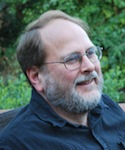 Evolution
Evolution
 Intelligent Design
Intelligent Design
James Barham’s “Seeing Past Darwin” Series
 Our friend and contributor James Barham has been generous enough to allow ENV to cross-post some of his fantastic blogging output, which you’ll find at his home-base, The Best Schools (where our friend Denyse O’Leary, the Dorothy Parker of pro-ID bloggers, also contributes).
Our friend and contributor James Barham has been generous enough to allow ENV to cross-post some of his fantastic blogging output, which you’ll find at his home-base, The Best Schools (where our friend Denyse O’Leary, the Dorothy Parker of pro-ID bloggers, also contributes).
Barham, who wrote for us about his intellectual journey as an atheist Darwin-doubter, has staked out an important position on the evolution question that is certainly not Darwinian reductionism but neither is it “classic ID theory,” as he puts it. He sees his view as a kind of “middle way,” which seems a fair description.
His top post that’s up now at TBS, fourth in his “Seeing Past Darwin” series, is particular fascinating.
Barham is currently surveying the work of scientists — Paul Bach-y-Rita, Martin Heisenberg, Mriganka Sur, Toshiyuki Nakagaki — who demonstrate the power of creatures ranging from human beings to slime molds to surmount challenges in ways that seem totally inexplicable on the Darwinian model:
Organisms of all sorts are capable of intelligent, goal-directed, adaptive behavior that cannot possibly be accounted for on the basis of the theory of natural selection.
Never in the evolutionary history of human beings was there selection for “seeing” with the tongue.
Never in the evolutionary history of fruit flies was there selection for adaptation to an inverted visual field.
Never in the evolutionary history of ferrets was there selection for the brain reorganization necessary to see with the auditory cortex.
And never in the evolutionary history of the slime mold was there selection for solving mazes.
Of course, the Darwinist will say that there is no need to posit past selection for plasticity. Instead, we will be invited to view plasticity as a “spandrel” — an accidental side effect of other abilities that were selected for.
But that would be entirely ad hoc. There is absolutely no evidence to support such a claim.
Moreover, it would be absurd, in terms of the relative significance of cause and effect.
To say that the massive reorganization exhibited by the brain in the first three experiments is a side effect of selection for some specific neural trait like vision would be like saying that binocular vision in all its complexity is a side effect of selection for the retina or selection for the lens. It would be to confuse the tail with the dog.
Another strategy that the desperate Darwinist might adopt would be to posit selection for an entirely general capacity for intelligent, goal-directed plasticity.
That is certainly a more promising way to go. However, such a strategy would still be tantamount to admitting defeat.
Why? Because it would be to acknowledge the existence of a fundamental, inherent, and quite general biological principle of what we might call “adaptivity.”
Why would that matter? Because the main task of Darwinian theory is to “reduce” teleology and normativity to mechanism.
Therefore, as soon as the Darwinist admits the reality of a general capacity for adaptivity extending throughout all of the living world, he has already given away the whole ballgame.
Read the rest there.
